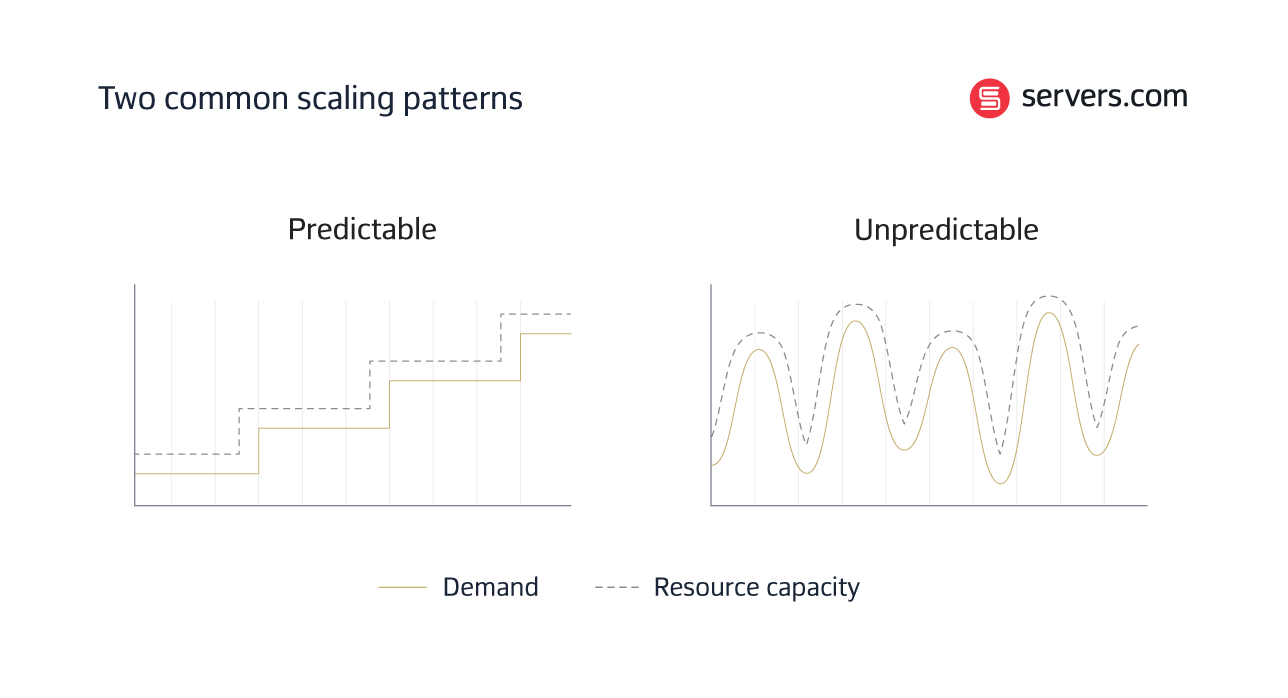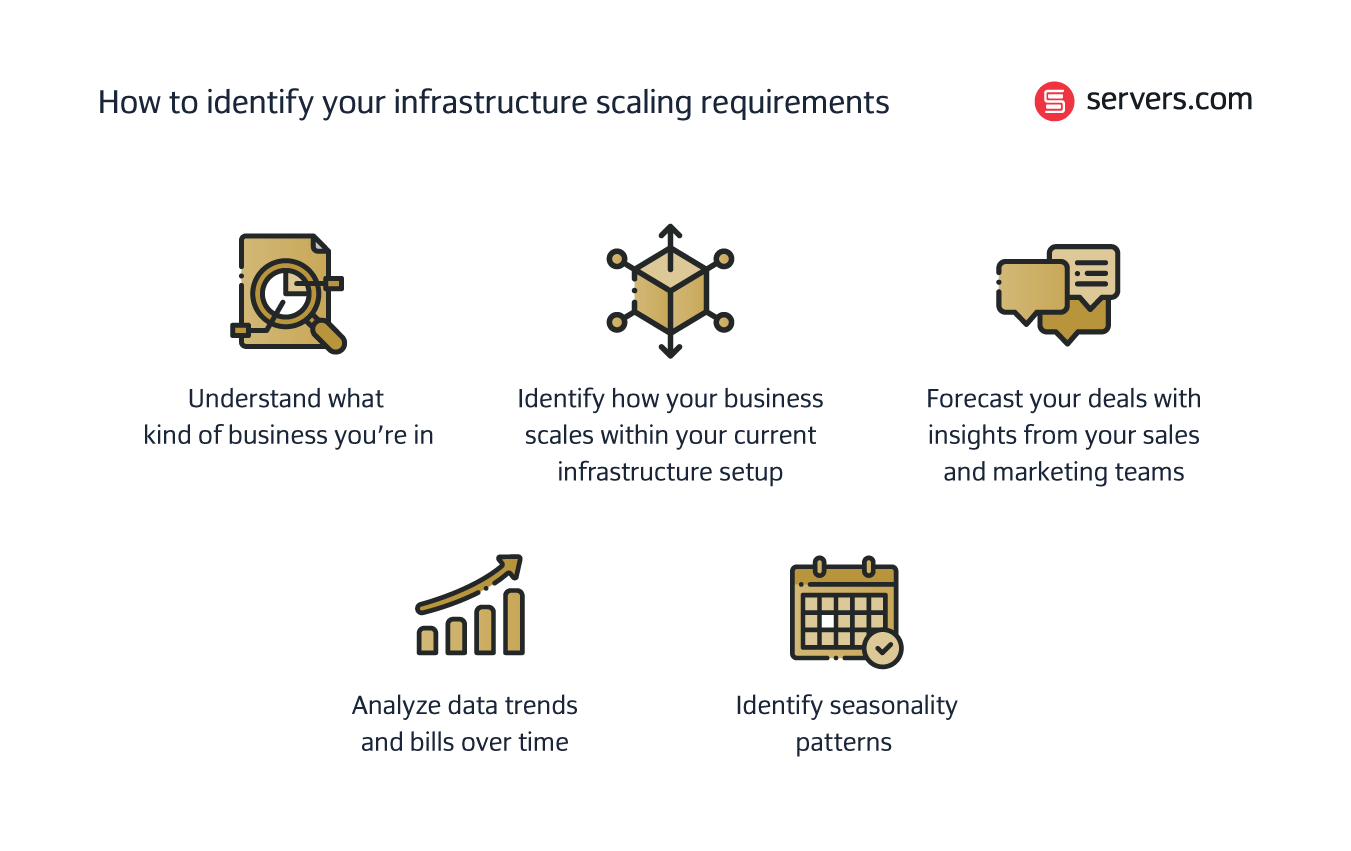

Unless you happen to have a technical background, when starting a business, it’s very unlikely that you’ll have a clear understanding of scalability – and what it means from an infrastructure perspective.
(Let’s be honest, I’ve also spoken to plenty of people in technical roles who also don’t have a clue.)
But, understanding your business’ infrastructure scalability requirements is vital. Not only to avoid downtime (and keep your business online) but to better manage spend.
You’d be surprised how many (even well-established) organizations don’t have a good handle on this. But, as I’ll explain, it’s about knowing where to look.
Infrastructure scalability means the extent to which an infrastructure solution can handle increases in resource demand without impacting performance. At its most basic, we can say that highly scalable infrastructure solutions can easily withstand traffic spikes.
For instance, spikes caused by soaring player numbers after the launch of a new game (take Fortnite which peaked at over 44.7 million players during the first day of Fortnite OG) or the increase in online shoppers around Black Friday. Less scalable solutions either cannot or may take longer to provision the additional resource capacity.
Nobody has a scalability crystal ball. I certainly don’t. If I did, I’d be a very wealthy crystal ball salesman. For startups, it’s especially hard to predict what level of demand to expect with any level of certainty. But most businesses’ scalability requirements will eventually conform to one of two basic patterns: predictable or unpredictable.
A business with predictable scaling requirements knows when scaling events are going to occur and can plan to provision additional bare metal servers or virtual machines ahead of time.
There’s no need for auto scaling when scaling events occur predictably so dedicated servers are a great fit here. You’ll be able to reduce infrastructure costs and scale at the same time – and get a more personalized service to boot.
A business with unpredictable scaling requirements experiences volatile demand spikes and can’t predict when a scaling event will occur. These spikes don’t typically last long, and some industries experience them more than others. Major streaming platforms like Netflix, for example, frequently need to handle viewership spikes around major releases. They need infrastructure that can be provisioned instantly to follow daily usage curves.
This is when cloud auto scaling comes into its own. When you’ve got no idea how many users are going to turn up on your website or application on any given day, being able to spin up virtual machines on the spot isn’t nice to have, it’s essential.

If you’re not sure what your scaling requirements are then it’s time to start doing some research. The resources you need are probably closer than you think.
Not all business models scale equally. It sounds basic, but if scalability hasn’t been on your radar until now it’s important to take a step back and identify what kind of business you’re running and what that means from an infrastructure perspective.
You can’t know how your business is going to scale right off the bat, so you’ll need cloud hosting or hybrid infrastructure until your scaling patterns become clearer.
Pinning down your scalability requirements can feel like crystal ball gazing. You never know when the next viral trend or celebrity endorsement could blow up the internet and cause a resource-capacity-breaking surge in demand.
Take the game OnlyUp! Which exploded in popularity last year after being streamed by American YouTuber Ludwig Ahgren. Or the once humble Stanley Cup, sales of which boomed after the product went viral on TikTok.
You’ll need to be on top of seasonality, holidays, internet trends, and key events throughout the year and should be collaborating with your marketing team to identify when scaling events are expected. If you’re a greetings card company, you’d better make sure you’re scaling a week before Valentine’s Day.
Ultimately, your scaling needs won’t be 100% predictable so a hybrid infrastructure approach combining bare metal hosting for steady resource requirements with cloud for emergency scaling is a good shout.
Scaling events tend to be less volatile in B2B organizations, but you should be collaborating with your sales team to understand your sales pipeline and forecasts. Particularly if you’re doing large enterprise deals for which each new customer means provisioning multiple additional servers.
Say you’re a B2B platform provider. Every time you sign up a new platform, you’ll need to provision dozens of additional servers in new locations – and on top of that there’s still the matter of seasonality to consider. Depending on the industry, it’s likely that demand will blow up in line with key events throughout the year so you should be provisioning additional servers around these to avoid downtime.
Top tip: Think about your business model and make sure you’re aligned with your sales representatives. If your business model revolves around getting new clients online in just one or two days, then you’re going to need near-instant provisioning (from a cloud service or very agile bare metal provider). If you’ll have weeks or months to plan, then bare metal hosting will meet your needs very well.
If you’re just starting out, this won’t apply. There’s no telling how a new business will scale after launch. And because of this, it is (in my opinion) the only scenario that warrants a 100% cloud environment.
But if you’re already established it’s a good idea to look at what’s already happening within your existing setup. You’d be surprised how many infrastructure as a service (IaaS) users don’t take advantage of the data that’s available on their dashboards and bills. These are two incredibly useful resources once you know what questions to ask.
Questions like:
Using the data from your dashboard or the expertise of your sales and marketing teams, start identifying seasonality trends. Look at your data and ask: were there any particularly busy days, months, or years and why? Do these peaks recur annually or correlate with key events in my industry? Is there a clear pattern that means I can plan to provision infrastructure around these times?

The first step to finding an infrastructure solution that fits your scaling needs is to go through all the steps above – even if you have a technical background I recommend taking the time to do this.
You might be a new CTO, under pressure from your CEO to reduce costs. Sure, short-term they’re going to be happy with you for going out there and finding the cheapest quote. But this is a common infrastructure hosting mistake and after a few months you’ll start to pay for not thinking about your scalability requirements earlier.
The moral of the story? Don’t come to the conversation with an infrastructure provider just saying, “I need a quote”. If you’re serious about finding a solution that meets your performance, cost, and scalability needs, only reach out once you’re informed and understand your requirements. If unsure ask for help.
You’d be surprised how many businesses, and established businesses at that, don’t do this.
When it comes to scalability, you don’t have to be an expert right off the bat, but you do have to be willing to put in the research.
There are so many reasons why people go into business. And let’s be honest, most of the time it’s not for a love of infrastructure. A business savvy, entrepreneurial, IT expert is a triple threat that’s hard to come by.
But you probably have all those skills within your company.
As Oliver Bossert and Björn Münstermann put it so well, “because technology can seem confusing, opaque, or intimidating, those on the business side prefer to leave it to the IT experts” but “if IT is to become a real driver of value, both business and IT must overcome bad habits and make a real commitment to being partners”.
Taking the time to understand your scaling patterns and how that translates to your infrastructure scalability requirements is one of the best investments you’ll make. That way, whether you opt for cloud, bare metal, or hybrid infrastructure you’ll know you’re making the best choice for your business.